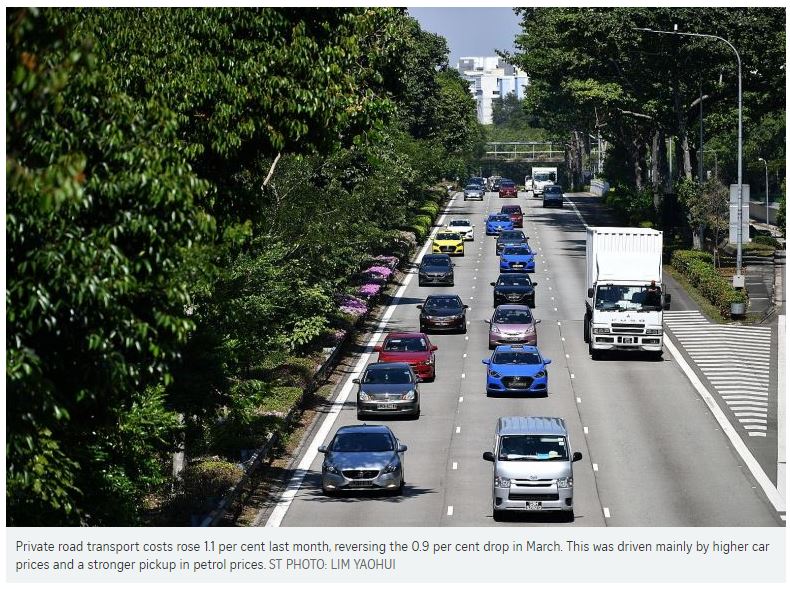Singapore: Core inflation eases to 1.3% but overall price index up
Core inflation in Singapore eased again last month, as a fall in the cost of electricity and gas as well as lower food inflation more than offset higher services inflation, according to data released yesterday.
Core inflation – which strips out private transport and accommodation costs – declined to 1.3 per cent on a year-on-year basis last month, after dipping to 1.4 per cent in March from 1.5 per cent in February.
Conversely, overall inflation rose slightly to 0.8 per cent year on year last month, from 0.6 per cent in March and 0.5 per cent in February.
This came as private road transport costs rose 1.1 per cent last month, reversing the 0.9 per cent drop in March. This was driven mainly by higher car prices and a stronger pickup in petrol prices.
Both core and overall inflation came in just as analysts polled by Bloomberg had expected.
United Overseas Bank economist Barnabas Gan said: “COE (certificate of entitlement) premiums rose earlier this month, led by both Category A and Category B prices. Brent crude also rose past the US$70 a barrel handle last month, the highest since November last year.
“Meanwhile, higher domestic services fees were seen last month as well, given that the non-concessionary foreign domestic worker monthly levy was raised last month as announced in Singapore Budget 2018.”
Services inflation came in at 2 per cent last month, higher than the 1.7 per cent in March. The Ministry of Trade and Industry (MTI) and the Monetary Authority of Singapore (MAS) said: “This was mainly due to larger increases in holiday expenses, domestic services fees, as well as recreational and cultural services fees, which outweighed the smaller increase in healthcare services fees. At the same time, the rise in airfares also contributed to the pickup in services inflation.”
The overall cost of retail items also edged up, reaching 0.2 per cent last month, compared with 0.1 per cent in March. This largely reflected smaller declines in the prices of medical products and telecommunications equipment, as well as price increases in personal care products and household durables, which more than offset a fall in the prices of clothing and footwear items, said the MAS and MTI.
MILD INCREASES EXPECTED
While global oil prices have risen in recent months, they are not expected to exceed last year’s average for this year as a whole. Global food prices should also pick up only slightly on average.
MINISTRY OF TRADE AND INDUSTRY AND MONETARY AUTHORITY OF SINGAPORE
But accommodation costs fell by 1.4 per cent, with housing rentals declining and housing maintenance and repair costs rising only slightly. Food prices eased to 1.3 per cent last month, down from the 1.6 per cent reported in March, as the prices of prepared meals and non-cooked food items registered a smaller rise.
The cost of electricity and gas fell by 2.8 per cent year on year last month, reversing the 3.9 per cent increase in the previous month. This was mainly a result of lower electricity tariffs and the dampening effect of the phased nationwide launch of the Open Electricity Market on electricity prices, the MAS and MTI said.
For the rest of the year, external sources of inflation are likely to be benign, they added. “While global oil prices have risen in recent months, they are not expected to exceed last year’s average for this year as a whole. Global food prices should also only pick up slightly on average.
“On the domestic front, labour market conditions remain firm and will support moderate wage increases, such that unit labour costs should continue to rise.”
The MTI and MAS added that an acceleration in inflationary pressures is unlikely against the backdrop of slower gross domestic product growth, uncertainties in the global economy, as well as the continuing restraining effects of the MAS’ monetary policy tightening last year.
Maybank Kim Eng economists Lee Ju Ye and Chua Hak Bin said the escalating trade war between the United States and China is also deflationary for a third country like Singapore. “A weaker yuan reduces import prices from China, commodity prices fall on weaker global growth and the US and China may divert excess supply to third countries.”
Core inflation is expected to come in near the mid-point of the forecast range of 1 per cent to 2 per cent this year. Overall inflation is expected to average 0.5 per cent to 1.5 per cent.
Source: https://www.straitstimes.com/business/economy/core-inflation-eases-to-13-but-overall-price-index-up


 Thailand
Thailand





